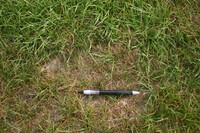 What is a field “Crown“? – The elevated center portion of a sports field, raised to promote the runoff of surface water. (Puhalla, Krans, & Goatley, 1999)
What is a field “Crown“? – The elevated center portion of a sports field, raised to promote the runoff of surface water. (Puhalla, Krans, & Goatley, 1999)
If surface water is not removed from the field:
- Surface becomes slippy and unsafe, as well as providing a poor spectacle
- Soil compaction will occur more readily on cohesive native soils, increasing surface hardness
- Oxygen is excluded from the soil and roots will not grow = grass pulls out during games & grasses will not be as stress tolerant (e.g. drought stress)
- Anaerobic conditions develop, leading to black layer problems & lack of important nutrients
- Cancellation of events/games
- Delayed maintenance practices e.g. mowing
- Increase in pest & disease problems (annual bluegrass etc.) because of wet favorable conditions or reduced grass health
- Soils take longer to warm up, so seed germination is delayed in spring





